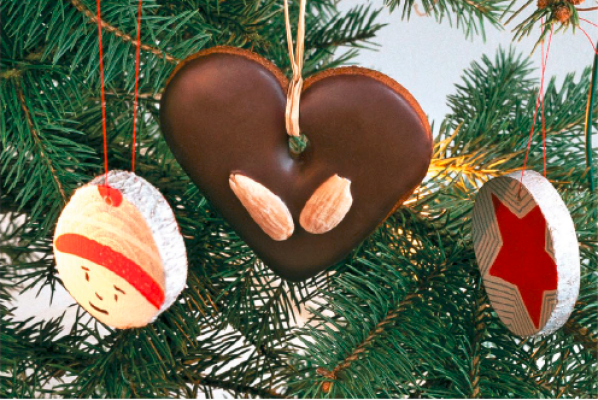These are a classic German tradition and should be on every Christmas tree! Nibbling is positively encouraged.

You will need:
For the biscuits:
- 1 tsp lebkuchen spices, from German stores or online
- 150g (5½oz) honey
- 50g (1¾oz) unsalted butter
- Pinch of salt
- 75g (2½oz) caster sugar
- 1 tbsp cocoa powder
- 50g (1¾oz) ground almonds
- 1 small egg, lightly beaten
- 275g (9½oz) plain flour
- 2 tsp baking powder
In addition:
- Baking tray
- Baking parchment
- Saucepan
- Rolling pin
- Heart-shaped cutter
- Wide straw
- 200g dark chocolate glaze, from German stores or online
- Bain-marie
- Handful of blanched almonds
- Frying pan
- Wire rack
- Thin ribbon
How to make Lebkuchen hearts?
Step 1: Preheat the oven to 200°C (400°F/Gas 6) and line a baking tray with baking parchment. Heat the honey, sugar, and butter in a saucepan until the sugar dissolves.
Step 2: Leave the mixture to cool slightly, then stir in the cocoa, ground almonds, spices, egg, and salt. Next add the flour and baking powder and mix until you have a smooth dough.
Step 3: Roll out the dough until it is about 5mm (¼in) thick and stamp out hearts. In the upper centre of each heart use a wide straw to punch a hole in the dough. Lay the hearts on the prepared tray and bake for 10–12 minutes, then leave to cool.
Step 4: Heat the chocolate glaze over a bain-marie according to the packet instructions until it has melted.
Step 5: Halve the almonds lengthways and toast them gently in a dry frying pan.
Step 6: Put the hearts on a wire rack, coat with the glaze and press 2 almond halves into the glaze. As soon as the glaze has hardened, you can hang the hearts on your Christmas tree with thin ribbon.

The custom of having a tree in your home and decorating it at Christmas time has been around for hundreds of years. The evergreen tree is a reminder of new life during the dark winter months, while lit candles are a symbol of hope.
Lebkuchen Hearts are a cherished Christmas tradition in Germany and have won the hearts of people all over the world
Lebkuchen Hearts are traditional German treats that are particularly popular during the Christmas season. These heart-shaped gingerbread cookies are beautifully decorated, often with festive sayings or intricate designs made with icing or marzipan.
The origins of Lebkuchen Hearts can be traced back to the 13th century in the city of Nuremberg, Germany. The recipe for these sweet treats has been passed down through generations and is still prepared with great care and attention to detail.
The main ingredients used in Lebkuchen Hearts include honey, various spices such as cinnamon, cloves, and nutmeg, ground almonds or hazelnuts, flour, and sometimes candied orange and lemon peel. The combination of these ingredients creates a deliciously aromatic and flavorful gingerbread dough.
Preparing the dough for Lebkuchen Hearts is a labor of love. The honey and spices are heated and mixed together before being combined with the ground almonds or hazelnuts. The flour is then gradually added to form a smooth dough. The dough is left to rest for a few hours or even overnight to develop the flavors.
Once the dough has rested, it is rolled out and cut into heart shapes using special cookie cutters. The hearts are then baked until they become firm but still slightly chewy. The baking process infuses the cookies with the warm and spiced aroma that is characteristic of Lebkuchen Hearts.
After the cookies have cooled, the fun part begins: decorating! The Lebkuchen Hearts are traditionally adorned with icing made from powdered sugar and egg whites. The icing can be used to spell out festive messages such as “Frohe Weihnachten” (Merry Christmas) or “Alles Gute” (All the Best), or to create intricate designs and patterns.
In addition to icing, Lebkuchen Hearts are sometimes embellished with small decorative items such as nuts or candied fruit. These decorations not only add a touch of elegance but also enhance the flavor and texture of the cookies.
Lebkuchen Hearts are not only a tasty treat but also a beautiful Christmas decoration. They are often hung on the Christmas tree using colorful ribbons or displayed in a festive basket as part of the holiday decorations. It is common to exchange these heart-shaped cookies as gifts or to offer them as a token of love and friendship during the holiday season.
Lebkuchen Hearts are a cherished Christmas tradition in Germany and have won the hearts of people all over the world. Their irresistible combination of honey, spices, and nuts, along with their beautiful decorations, make them a perfect treat to enjoy during the festive season. Whether eaten with a warm cup of tea or given as a gift, Lebkuchen Hearts are sure to bring joy and cheer to any Christmas celebration.
Lebkuchen Hearts are traditional heart-shaped gingerbread cookies that are often decorated with icing and messages. They have a long history and cultural significance in Christmas celebrations, particularly in Germany and other European countries:
The origins of Lebkuchen Hearts can be traced back to medieval times in Germany, where gingerbread was a popular treat reserved for special occasions. The use of heart shapes can be attributed to the influence of Valentine’s Day, which became associated with love and affection during the Middle Ages in Europe.
Lebkuchen Hearts gained prominence during the Christmas season in the 13th century, when they began to be used as decorations on Christmas trees. The intricate designs and colorful icing made them popular as ornaments and gifts during the festive period. Over time, they became synonymous with Christmas celebrations and are now a beloved tradition in many households.
The cultural significance of Lebkuchen Hearts lies in their symbolism and messages. The hearts often feature phrases such as “Frohe Weihnachten” (Merry Christmas), “Ich liebe dich” (I love you), or personalized messages. They are often exchanged between family members, friends, and loved ones as a way of expressing affection and spreading holiday cheer.
In addition to their cultural significance, Lebkuchen Hearts also hold symbolic meanings. The heart shape represents love, warmth, and togetherness, which are central themes of the Christmas season. The gingerbread itself is believed to have a warming effect on the body, making it a perfect treat for the cold winter months.
Lebkuchen Hearts are not only enjoyed in Germany but also in many other European countries, where they have become an integral part of Christmas traditions. They are often sold at Christmas markets and fairs, and can be found in various sizes and designs.
Lebkuchen Hearts have a rich history and cultural significance in Christmas celebrations. They are not only delicious treats but also symbols of love, affection, and togetherness during the festive season.
A detailed recipe for making Lebkuchen Hearts at home:
- Ingredients:
– 2 cups all-purpose flour
– 1/2 cup ground almonds
– 1/2 cup honey
– 1/4 cup molasses
– 1/4 cup brown sugar
– 1 tsp baking powder
– 1 tbsp Lebkuchen spice mix (a combination of ground cinnamon, cloves, nutmeg, coriander, ginger, allspice, and cardamom)
– Zest of 1 lemon
– Zest of 1 orange
– 1/4 cup candied citron peel, diced
– 1/4 cup candied orange peel, diced
– 1/4 cup dried cranberries (optional)
– 1/4 cup chopped nuts (such as hazelnuts or almonds) - For the glaze:
– 1 cup powdered sugar
– 2 tbsp lemon juice
– 2 tbsp water
Instructions:
- In a mixing bowl, combine the flour, ground almonds, baking powder, Lebkuchen spice mix, lemon zest, and orange zest. Set aside.
- In a small saucepan, heat the honey, molasses, and brown sugar over low heat until well combined. Stir continuously to prevent burning. Remove from heat and let it cool for a few minutes.
- Once the honey mixture has cooled slightly, pour it into the dry ingredients. Mix well until a dough forms. If the dough feels sticky, add a little more flour until it reaches a workable consistency.
- Stir in the candied citron peel, candied orange peel, dried cranberries (if using), and chopped nuts. Knead the dough gently until all the ingredients are evenly distributed.
- Wrap the dough in plastic wrap and refrigerate for at least 1 hour, or overnight if possible. Chilling the dough helps develop the flavors and makes it easier to shape.
- Preheat your oven to 350°F (180°C) and line a baking sheet with parchment paper or a silicone baking mat.
- On a lightly floured surface, roll out the chilled dough to a thickness of about 1/4 inch (0.6 cm). Use heart-shaped cookie cutters to cut out the Lebkuchen hearts. Place them on the prepared baking sheet, leaving a little space between each heart.
- Bake the Lebkuchen hearts in the preheated oven for about 12-15 minutes or until they are golden brown around the edges. Keep a close eye on them, as they can brown quickly.
- While the Lebkuchen hearts are cooling on a wire rack, prepare the glaze. In a small bowl, whisk together the powdered sugar, lemon juice, and water until smooth. Adjust the consistency by adding more powdered sugar or water if needed.
- Once the Lebkuchen hearts have completely cooled, use a pastry brush to generously glaze each heart with the prepared glaze. Let the glaze set completely before storing them in an airtight container.
Lebkuchen Hearts are traditionally enjoyed during the holiday season, and they taste even better after a couple of days when the flavors have melded together. They can be stored for several weeks, allowing you to enjoy them throughout the festive period.
Lebkuchen Hearts have evolved significantly over time, both in terms of their design and ingredients. Originally, they were simple gingerbread cookies decorated with icing or sugar. Over the years, Lebkuchen Hearts have transformed into larger heart-shaped cookies, often adorned with elaborate designs and personalized messages. Nowadays, they are commonly sold as souvenirs or gifts, particularly during festive seasons like Christmas and Valentine’s Day.
Lebkuchen Hearts are a traditional German Christmas gingerbread cookie known for their heart-shaped design and decorated with icing messages. Here are some popular variations or regional variations of Lebkuchen Hearts:
- 1. Nürnberger Lebkuchen: Originating from Nuremberg, Germany, these Lebkuchen Hearts are typically made with a combination of spices, nuts, and candied fruits. They have a soft and cake-like texture and are often covered with a thin glaze of sugar or chocolate.
- 2. Aachener Printen: Hailing from Aachen in western Germany, Aachener Printen are a type of Lebkuchen that feature a slightly harder and chewier texture compared to traditional Lebkuchen Hearts. They are usually flavored with spices like anise, cinnamon, cloves, and coriander.
- 3. Elisenlebkuchen: Elisenlebkuchen, also known as “premium Lebkuchen,” are a high-quality variation made with a high percentage of nuts, such as almonds and hazelnuts, as well as various spices and honey. They often have a moist and dense texture and are generally covered with a thin layer of chocolate or sugar glaze.
- 4. Herzenlebkuchen: Herzenlebkuchen, meaning “heart Lebkuchen,” are similar to traditional Lebkuchen Hearts but may have different designs or decorations. For instance, they might be adorned with edible images, sprinkles, or more intricate icing motifs. The flavors and shapes remain similar to the classic Lebkuchen Hearts.
- 5. Swiss Lebkuchen Hearts: In Switzerland, Lebkuchen Hearts are also quite popular, and they often feature unique regional variations. These variations may include the addition of honey, candied citrus peels, or almonds to the dough, giving them subtly different flavors compared to the traditional German Lebkuchen Hearts.
While the basic concept of Lebkuchen Hearts remains the same, variations in regional recipes and techniques result in differences in flavors, textures, and decorations.
Frequently Asked Questions: Lebkuchen Hearts
Lebkuchen Hearts are traditional German Christmas cookies made with a mix of honey, spices, nuts, and candied fruits. They have a soft and chewy texture and are often covered in a thin layer of sweet icing. These cookies are shaped like a heart and are usually decorated with colorful icing or personalized messages.
Lebkuchen is said to have originated in Nuremberg, Germany, during the medieval times. The cookies were initially made by monks and have since become a cherished Christmas tradition throughout Germany and other parts of Europe.
Lebkuchen Hearts require a combination of butter, honey, sugar, flour, nuts (such as almonds or hazelnuts), a variety of spices (such as cinnamon, cloves, ginger, and nutmeg), and candied fruits (like orange peel or citron).
The dough is prepared by mixing the ingredients until well incorporated, and then it is left to rest for a few hours or overnight to allow the flavors to meld together. Once the dough has rested, it is rolled out to a desired thickness and cut into heart shapes. These hearts are then baked until they become golden brown and fragrant.
Absolutely! One of the charming aspects of Lebkuchen Hearts is that they can be customized with personalized messages or designs. This is typically done by piping colorful icing onto the cookies, allowing for creative and individual touches. Some popular messages include “Frohe Weihnachten” (Merry Christmas), “Alles Liebe” (All my love), or adding the recipient’s name.
Traditional Lebkuchen Hearts are not typically gluten-free or vegan-friendly due to the use of flour, butter, and honey in the recipe. However, there are alternative recipes available that cater to specific dietary needs, such as using gluten-free flour or substituting ingredients like coconut oil for butter and agave syrup for honey.
When stored in an airtight container at room temperature, Lebkuchen Hearts can last for several weeks. Their flavors tend to develop and intensify over time, making them even tastier as the days go by. However, due to their deliciousness, they are often consumed well before their expiration date!
Yes, Lebkuchen Hearts can be shipped internationally. They are popular treats that are enjoyed not only in Germany but also worldwide. However, it is important to check the import regulations of the recipient’s country to ensure that there are no restrictions on food items.
While the traditional Lebkuchen Hearts remain the most popular, there are a few variations available. Some popular variations include chocolate-coated Lebkuchen Hearts, marzipan-filled Lebkuchen Hearts, and Lebkuchen Hearts with a layer of edible wafer on the bottom.
Absolutely! Lebkuchen Hearts can be made at home with the right ingredients and a little effort. There are numerous recipes available online that provide step-by-step instructions for making these delectable treats. They can be a fun holiday baking project to enjoy with friends and family.
Traditional Lebkuchen Hearts often contain nuts, such as almonds or hazelnuts. However, if you have a nut allergy, you can explore alternative recipes that exclude nuts altogether or replace them with other ingredients like seeds or dried fruits for added texture and flavor.






























